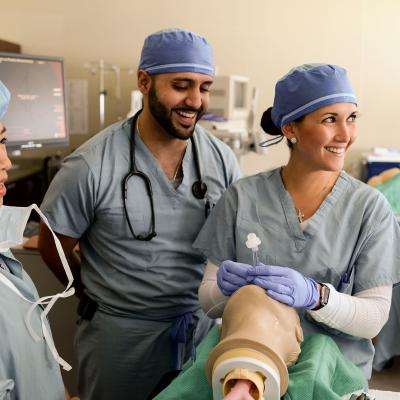- AdventHealth University

Written By Lukus Staup, B.S., R.T.(R)(MR)
“Why?” It is a very natural response when given instructions. Our brain immediately wants to understand why we must follow specific instructions. If you have visited the imaging department of any healthcare facility, this question and others have probably crossed your mind several times. Sometimes, the questions you are asked and tasks you must do might seem strange and unnecessary, but believe it or not, there really is a good reason.
Medical imaging technologists have a challenging task: to provide excellent, patient-centered care and deliver quality diagnostic images. To do so, there are specific steps a technologist must take before, during, and after the exam to ensure that the patient is prepared.
Here are 5 things you might be asked or told when getting an imaging exam done:
1. Do you have any implants? Particularly, metallic implants are a concern, such as a pacemaker, joint replacements, aneurysm clips, and stents. If you have a metallic implant, it doesn’t necessarily mean that you cannot have the imaging exam. It is important, however, for the technologist to know of any implants so when they plan the exam, they can take steps to accommodate the implant. For example, if you have a hip replacement and are getting a Computed Tomography (CT) scan done of your pelvis, the prosthesis can cause streaks in the resulting CT image. If the technologist is aware of the implant before performing the scan, there is special software, called metal artifact reduction, that can be used to reduce the streaking effect, resulting in higher quality images. With certain modalities, some implants can cause harm to the patient, most notably with MRI or Magnetic Resonance Imaging. This modality uses strong magnetic fields to acquire images and when certain metals are in the presence of a magnetic field, the implant can heat up and cause damage to the surrounding tissues in the patient or even move out of place.
Because of these concerns, medical implant documentation must be provided to the imaging department prior to the exam. Anytime a medical implant is placed in a patient, a manufacturer’s card will be supplied to the patient with information pertinent to medical imaging modalities. At the very least, this card should include the manufacturer and model number of the implant. Most implants will have information on the manufacturer implant card regarding MRI safety and the conditions necessary to safely perform an MRI exam. This information must be thoroughly examined prior to the start of an exam to ensure proper operation and patient safety. Without this information, implant safety cannot be confirmed, and your imaging exam may be rescheduled or not happen at all.
2. Can you please change into a gown? But what if you’re not wearing anything metal…do you still have to change? The answer is most likely “Yes.” Many imaging facilities have adopted strict policies regarding what clothing may be worn during imaging exams. ALARA (as low as reasonably achievable) is a guiding principle of radiation safety and serves to guide the technologists in keeping the exposure to ionizing radiation as low as possible1. With this principle in mind, it is important to understand that clothing can contain fabrics or objects that might cause artifacts (an unwanted image appearance) or obstruct the area of interest. For modalities utilizing ionizing radiation, this is a big concern, since a repeated image or scan due an artifact increases the total radiation exposure dose to the patient. Even for modalities that do not utilize ionizing radiation, clothing with certain fabrics can pose a serious risk to patients and possibly result in physical injury. More recently, it has been found that clothing can actually cause MRI-related burns due to the prevalence of fabrics containing nondetectable metallic microfibers, which can be found in some athletic clothing. Rather than take the risk, it is best to have patients change into gowns or other appropriate attire that do not contain metallic materials in order to prevent MRI-related burns2.
3. This exam will take 45 minutes to 1 hour. Wait…what? Hopefully, the day of your exam is not the first time you are hearing this information, but sometimes patients are not told in advance the length of their exam. Depending on the imaging modality, exam times can vary greatly and are typically based on the anatomy of interest and the specific requirements of the test. Generally, exam times are usually communicated to the patient when the exam is scheduled. If not, this is an important question for you to ask. This will allow you to prepare and plan your day accordingly, enabling you to focus on successfully completing your imaging exam. Keep in mind that sometimes, there are unavoidable circumstances that might increase the length of your exam. If you are receiving intravenous (IV) contrast and your veins are typically hard to find, this can cause a slight delay. Also, particularly with MRI, if you happen to move during one of the sequences, it may warrant the need to repeat that sequence, adding 7 to 10 minutes more to your exam time. When planning for your exam, be sure to budget extra time to allow for any delays that might occur.
4. Did you follow your exam prep instructions? For some imaging exams a patient preparation protocol is necessary. These patient prep instructions will vary from test to test, but can include fasting for a certain length of time, drinking provided contrast material, or taking certain medications, like laxatives. The scheduling department or your physician typically provides this information. If you are unclear about the instructions, be sure to ask questions. Preparation is mandatory for many exams and if not followed correctly, the exam may have to be rescheduled.
5. Hold your breath! Many exams may require specific breathing instructions to obtain quality diagnostic images. Imaging modalities utilize breathing instructions to reduce motion that occurs from normal breathing or to reposition overlying structures that could obscure the anatomy of interest. Motion can cause streaks or blurriness in the images, resulting in poor image quality. Breathing instructions can vary depending on the exam, sometimes requiring patients to hold their breath for 5 to 30 seconds. Typically, the technologist will coach patients prior to the exam to gauge their level of understanding. Incorrectly performing breathing instructions can result in repeat images and for exams utilizing ionizing radiation, this will mean an increase in the patient’s cumulative radiation dose. For some people, holding your breath can be extremely difficult and tiresome. If this is the case, it is important to speak with your physician so that alternative options for acquiring the necessary images are explored.
Healthcare has evolved from the days of the “doctor-knows-best” culture. Today, patients have a much more active role in their care, and in order to make informed decisions it is important that the patient is…informed. Taking the time to educate yourself about the procedure that has been ordered will help make the experience smoother, reduce delays, and result in a higher quality exam.
Learn More about AHU Online
AHU Online provides imaging technologists online opportunities for career advancement or credentialing through a rigorous, but nurturing and highly reputable, healthcare environment. Learn more about our advanced imaging certificates and bachelor’s degree programs on our website.
Sources
- Centers for Disease Control and Prevention. [Online] December 7, 2015. [Cited: July 17, 2018.] https://www.cdc.gov/nceh/radiation/alara.html.
- Frank G. Shellock, Ph.D. MRIsafety.com. [Online] 2017. [Cited: July 17, 2018.] http://www.mrisafety.com/SafetyInfov.asp?SafetyInfoID=166.


